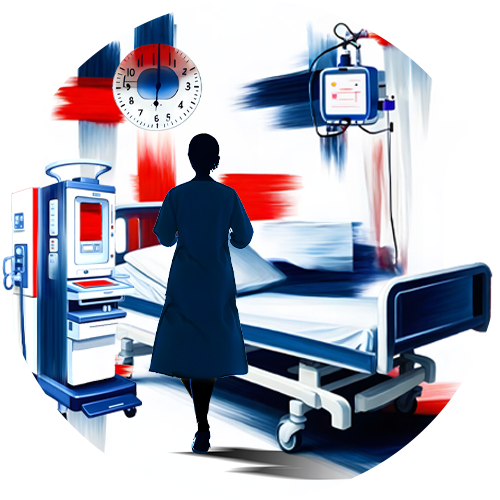On Call: Chapter 1
| April 2, 2024It never entered my mind that this was something that I, Ayala Rubin, could actually do

As told to Shoshana Gross
Welcome to the ER
“T
he heart is a pump,” I remember one of my professors telling us in med school, as he pointed out the various parts on a clinical diagram.
The heart in front of me is… different. It’s pink and soft, the tracery of quivering red veins and arteries both fascinating and strange. And it’s in my hands. I’m squeezing rhythmically — it’s surprisingly easy — over and over, trying to keep the man on the stretcher alive.
IT starts with the piercing ring of my pager and the ominous words, “Code Trauma, Code Trauma,” repeated in that even, passionless voice on the overhead speakers. Before the echoes die away, I’m heading rapidly to the trauma bay. The first few days of my residency were filled with fruitless wandering through the warren of twisting, blindingly white, sterile corridors, but I’m finally making sense of the tangle, and I reach the room swiftly.
Residents and nurses converge from all directions in what looks like a chaotic mess but is really a carefully choreographed scene. The medics wheel a wounded man in on a stretcher, and I take up my place near where the patient’s right leg will be.
“He’s in pretty bad shape,” one of the medics states grimly. “Multiple gunshot wounds to the chest. We had a pulse and then lost it.”
The nurse starts powerful chest compressions, while I grab a cordis IV line that can be used for rapid blood transfusions and carefully insert it into the femoral artery at the crease of the man’s right thigh.
“He needs a thoracotomy,” one of the doctors says tersely. I’ve never seen one before, but I learned the theory so well that I can recite it in my sleep. In medical jargon, it’s called a clamshell thoracotomy, a euphemism for a pretty drastic medical maneuver. A quick incision is made from the sternum to the ribs, a powerful retractor separates the protective cage of rib bones, an axe and mallet crack open the sternum — the bone over the heart — and we can try to save the patient from the inside out.
This patient’s heart isn’t beating on its own, and that’s when I find myself with his heart in my hands, squeezing for his life.
Welcome to the ER.
When my elementary teacher asked us the inevitable, “What do you want to be when you grow up?” I never thought of being an emergency medical physician — the colloquial ER Doctor. I loved going to the doctor’s office, and I was fascinated by all the medical procedures, but it never entered my mind that this was something that I, Ayala Rubin, could actually do.
Until I was 15, when everything changed.
My younger brother had broken his finger badly during a casual game of basketball, and a frum nurse practitioner from around the corner came to examine him. She suspected a break, put on a basic splint, and urged an immediate trip to the ER. It was a long Friday afternoon, but the wait in the ER was even longer. When my father and brother sprinted into the house an hour before Shabbos, the nurse practitioner came over again to see how the injury was doing.
I watched her — this ordinary-looking frum woman, this mother of children who looked very much like my own mother, this kind individual who had probably left Erev Shabbos chaos behind to help us, this lady who knew so much about the intricacies of the human body — and the feeling crystallized: I wanted to be like her. At least, partly like her. If I was going into the medical field, I would go all the way.
“Are you going to be a PA? A nurse?” a well-meaning aunt asked.
“Nope,” I answered decisively. “I’m going to be a doctor.” The doctor is the general on the front lines of medicine, and I wasn’t going to settle for anything less.
This was a decision I made as I learned more about the medical field, read books about medicine, and spoke to nurses and doctors in our community — but it was not a conclusion I reached on my own. Was this really the field to fulfill my unique talents and passions? There were multiple conversations with our family rav, as we discussed the pitfalls and challenges I might encounter — from medical issues to my becoming a wife and mother one day. They were not simple discussions, but they gave me the clarity to realize that this wasn’t a journey I could take without continued guidance.
To my parents’ credit, they never tried to discourage me from pursuing my dream, which was fortunate, because the process is discouraging enough. (And that’s besides the “S” word — shidduchim. Which young man was going to want to marry an ER doctor? Thankfully, someone did, but that’s a tale for another time.)
Most people don’t know how difficult it is to get into med school. First comes the grueling MCAT test, something along the lines of an SAT, where anyone who really wants to have a medical career should score in the top 20th percentile. Then you apply, along with thousands of other people, praying that you’re in the one-third of applicants who are accepted. Once I cleared that hurdle, there were two years of academic studying and two years of clinical studies, when I made the rounds in hospitals and learned on the job how impossibly deep and broad the medical field really is.
I’m usually a decisive person, but figuring out where in the medical world I wanted to go was one of the most challenging decisions of my life. Until I worked in the ER. It’s tough, but it’s so much more than that. There’s nonstop action, a blur of patients seen and discharged, surgical procedures, lifesaving techniques, infections… endless variety, excitement, and instant responses and results. It’s a place of drama and despair, but also deep fulfillment. This is “emergentology,” where we know the first 30 minutes of care in any medical specialty you can name. As a medical student, stitching the ulnar nerve back into a young teenager’s elbow under the eye of the attending doctor, I finally knew. The ER fit like a well-worn scrub shirt. I was staying.
Med school is behind me, and the most difficult three years of the process are ahead of me: residency. My time is not my own, the schedules encompass more hours than I care to think about, and the learning curve is so steep, I’m starting to understand the wry humor behind the comparison between first-year residency and drinking from a fire hose.
As a newly married frum woman, I know that the years of residency will bring mountains to climb — but I’ve got my eyes on the summit.
I squeeze the fragile organ in my hands again… pump blood through the lungs, pump blood through the body… over and over we work to keep hope alive until we can reach the operating room. Everyone in the trauma bay knows there’s only a three to seven percent chance of survival after a thoracotomy, but we’re not stopping.
I don’t know if we’ll save this patient; he is — as that medic put it in a glorious example of understatement — in pretty bad shape. But here, we have a chance to try.
Welcome to the ER.
The characters in this series are composites; all the stories are true.
(Originally featured in Family First, Issue 888)
Oops! We could not locate your form.


